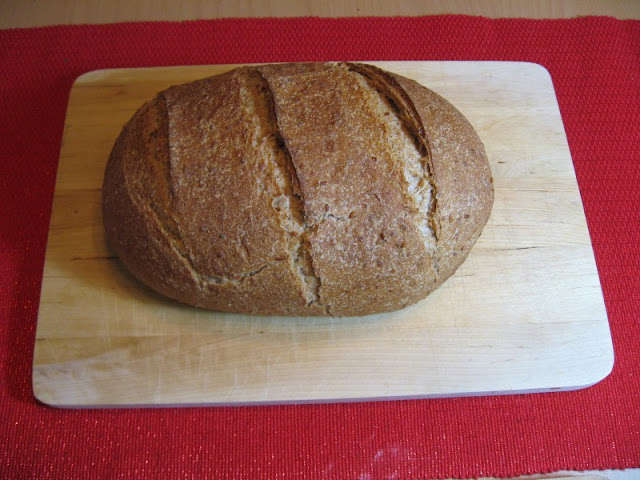Or
A good sandwich bread after a long time
In looking back through my folders of bread pictures, I saw that I had made this bread from Laurel Robertson's 'The Laurel's Kitchen Bread Book' in July 2010. I didn't write any notes then so I don't know what I thought about it, but based on the pictures, the bread didn't rise too much and it was sliced fairly thick. I picked this recipe because I have been wanting to make sandwiches for some weeks now and bread with rye is bound to be more flavorful than whole-wheat-only bread.
The recipe
The recipe can be found
here
I made half the recipe and, like a
previous bread, wrote down the measurements for half the recipe to avoid mistakes. The 'sour' in the recipe comes from using cider vinegar and yogurt.The recipe calls for cornmeal, I think I've used corn grits in the past. Cornmeal is much finer and blends in better with the other ingredients. The cornmeal is mixed with boiling water first and other wet ingredients (yogurt, cider vinegar, oil, honey) are added to it later. Yeast is mixed with water and put aside. I used slightly lesser quantity of instant yeast and proofed it even though instant yeast isn't usually proofed. The recipe called for first mixing the cornmeal mixture and then the dissolved yeast. I wanted to keep that order of adding ingredients, although in hindsight, it would have been acceptable to add the dry instant yeast to the flours first. The flour mixture contains whole wheat flour, rye flour, caraway seeds and salt. I added two tsp of vital wheat gluten to make 'whole wheat bread flour'.
 |
| Ingredients |
 |
| Three mixtures |
 |
| After just mixing in |
The interesting change in the dough making process is working in about ¼ cup water during the kneading process. The dough is very sticky (doughs with rye flour usually are) and wetting hands with water and kneading makes the kneading easier. After the water has been mixed in, the instructions say to stop when the dough gets sticky. You can't miss this, it's so obvious.
The risings (rises?)
 |
| Ready for first rise |
Usually the first rise is done in an hour in the warm AZ summer (the book says it will take about 90 minutes). However after an hour, the dough had barely risen. I decided to be patient and give it time and sure enough, after two and a half hours, it had risen as expected.
 |
| After the first rise |
 |
| Rounded and ready for second rise |
The dough remained sticky as seen by the hole poked in to test the completion of the second rise.
 |
| Sticky dough after the second rise of 70 minutes |
Proofing and baking
I was very tempted to bake this one in the cast iron combo cooker but the desire to have sandwiches won and I stuck with the loaf pan. The book recommends the pan be greased and dusted with cornmeal. I skipped this step.
 |
| Shaped |
 |
| 50 minutes of proofing time |
 |
| Poor slashes in sticky dough |
The loaf is baked in a 400º F oven for 10 minutes and then for 55 minutes at 350º F.
 |
| Out of the oven |
 |
| Fairly dark crust |
 |
| Sliced clean and thin, the way we like it |
 |
| Good looking crumb |
The bread
The bread has a very intense flavor, distinct taste of rye and fairly sour, in a good way. I think the long first rise gave the dough plenty of time to develop the flavors. I was glad it sliced thin, works well for sandwiches. We had some roasted red pepper, tomato and melted cheese sandwiches and they were pretty darn good. No nut butters on this one.
Notes
Date: June 19, 2011
Recipe: Sour Corn Rye from Laurel Robertson's book, 'The Laurel's Kitchen Bread Book'
Flours: Whole wheat, rye flour, cornmeal
Bread specific ingredients: Caraway seeds
Sweetener used: Honey
Liquid: Yogurt, water
First rise: 157 minutes
Second rise: 70 minutes followed by rounding and 15 minutes of resting
Proofing: 50 minutes
Comments: Used instant yeast (proofed), about ¾ tsp instead of the 1 tsp of active dry yeast recommended. I wonder if my yeast is getting old and that's why it took a long time to rise. Watch for yeast rise in the next bread. Used 2 tsp vital wheat gluten. A little less cider vinegar might be better. Cornmeal is much better in breads than corn grits. Water used to mix cornmeal wasn't really at boiling point, but that didn't seem to adversely affect the bread. Lesson learned: sometimes the dough needs more time to rise and should be given the time even though it deviates considerably from the book or normal rising times.
Baking can be tough when the temperature outside is 108º F and the air conditioning can barely keep the inside temperature at 85º F. Three more months...
-RPH






















































